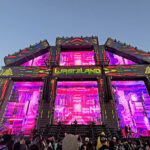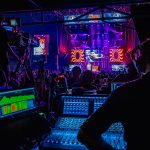Girls in kabuki-style makeup donning butterfly wings, dancers in floppy panda suits, faux hippie chicks in rose-colored sunglasses and a halo of flowers around their heads, giant daisies like something straight out of a Lewis Carroll opium delusion. Welcome to the Electric Daisy Carnival (EDC), often dubbed North America’s largest electronic music festival, where the phrase “making a scene” has never been more apt.
The psychedelic visual delights witnessed at EDC’s 2015 New York City-area event, held at MetLife Stadium in East Rutherford, NJ, on Saturday May 23 and Sunday May 24, matched the butt-moving, kaleidoscopic sounds emanating from the festivals’ four major stages. But although EDC New York boasted quite an assortment of top-shelf DJs, including Hardwell, Martin Garrix, Knife Party, Tiësto, Benny Benassi, Flux Pavilion, Eric Prydz and others, music was but a drop in a veritable sea of sensual diversions.
As one might expect, the main stage, located in Kinetic Field and built by world-renowned staging group, Stageco (stageco.us), was big, bold, and unforgettable. Stacks of audio equipment pumped out ear-bleeding bass, blinding moving light fixtures sprayed the ecstatic crowd, skyrocketing fireworks and billowing puffs of pyro clouds shot into the night sky, video screens simulating cathedral-style stained glass windows bumped up the aesthetics, and a pair of giant inflatable owls (courtesy of Netherlands based manufacturer Airworks), guided attendees through a mystical experience focusing on the spectacle and mysteries of worlds both natural and supernatural.
Although much detail was adorned on its main stage, and for all its hippie dippy surface trappings and surrealistic visuals, EDC is nothing if not immersive and surprisingly deep. We often take for granted the sheer manpower and engineering know-how required to set up so-called secondary locations at music festivals. At EDC these stages not only pack quite a visual punch, but are also engineering marvels in their own right.
Who’s on “Second?”
Toiling tirelessly for a week before the show, crewmembers working on these secondary and auxiliary areas literally “made the scene” — they built the major stages and notable support structures in MetLife’s roomy parking lot (the actual festival location site), helping to foster an atmosphere in which concertgoers can let their freak flags fly.
Ironically, these “B”, “C” and “D” stages would easily be main attractions at most major or moderately-sized festivals in America. Intrigued by this concept, PLSN contacted Quebec-based Stageline/Mobile Stages and Mountain Productions out of Wilkes-Barre, Pa., whose behind-the-scenes handiwork made the whole darn thing possible.
“We are necessary to make the show happen, but we do not want to be the show,” says Pierre-Luc Rompré, commercial sales director at Stageline/MSR. “People come to the festival to see the artist and the light show, but not necessarily pay attention to the infrastructure. If we’re not noticed we’re doing a good job.”
Serious Fun
Produced by concert and nightclub promoter Insomniac (insomniac.com), Electric Daisy Carnival is the brainchild of founder Pasquale Rotella. The show initially appeared in nascent form at Los Angeles’ Shrine Auditorium back in the 1990s. The meteoric and parallel rise of the electronic dance music field as a revenue generator and Insomniac’s growing influence has transformed EDC into a must-see annual electronic dance music extravaganza.
Today, Insomniac runs more a dozen annual festivals across the globe. Along with the Electric Daisy Carnival in the New York metro area this May, full-scale EDC events took place/were slated for Las Vegas (June 19-21), the U.K. (July 11), Orlando (Nov. 6-7) and Brazil (Dec. 4-5). Insomniac also stages other festivals, with brands including Beyond Wonderland, Nocturnal Wonderland, White Wonderland, BassCon, BassRush and more. When EDC’s traveling caravan picked up stakes and arrived at MetLife Stadium for the 2015 shows, organizers were predicting that the two-day event’s total “turnstile clicks” would approach the 100,000 mark.
But before all the EDM ballyhoo and the bikini babes bared their skin in bright rays of the sun, the serious fun began, as crews set up the stage configurations for areas such as the Circuit Grounds, Neon Garden, Cosmic Meadow and other auxiliary locations.
 Stageline, responsible for the Circuit Grounds stage, which hosted Armin van Buuren, Calvin Harris, DJ Snake, Krewella, Nicky Romero, Duke Dumont, Kaskade, Afrojack, Jack Beats among others, pulled into MetLife with their SAM750 stage, a serious piece of heavy metal requiring seven trailers, four of which carried the essentials for the stages and three for accessories.
Stageline, responsible for the Circuit Grounds stage, which hosted Armin van Buuren, Calvin Harris, DJ Snake, Krewella, Nicky Romero, Duke Dumont, Kaskade, Afrojack, Jack Beats among others, pulled into MetLife with their SAM750 stage, a serious piece of heavy metal requiring seven trailers, four of which carried the essentials for the stages and three for accessories.
The SAM750 stage, which measures 70 by 50 feet (LxW), has been dubbed the “largest mobile stage ever produced.” Its design, and the manner in which it’s dispatched, is remarkable and was developed to comply with North American road regulations (i.e. trailers are limited to 53 feet in length).
“[The stage] unfolds sideways off the truck,” says Rompré. “It makes better use of that 53 feet. Everything’s rotated 90 degrees, so the downstage portion of your stage is located at the end of your trailer. Upstage, the front of the trailer.”
In the initial stages of the build, on day one, the 53-foot-plus floor trailer discharged its cargo, and is transformed into a 70-foot by 50-foot flooring surface was deployed hydraulically, the floor resting nearly eight feet off the ground.
Next, a 51-foot trailer was aligned with the floor, and the 70-foot by 48-foot fiberglass roof, all 44,000-pounds of it, was transferred to the flooring via a pulley and rail system. The roof is then opened using a hydraulic winch mechanism.
“We use one trailer for the floor, one trailer for the roof, and two to carry all the baseplates, columns receptacles and the hydraulic telescopic columns used as a lifting device for the roof,” says Rompré. “Three other trailers carry covered wings, extra extensions platforms, guardrails, legs, other structural beams, and all the soft goods, like the wind walls. These last three trailers are also used as the main frame for the crossover loading dock, which features a hydraulic ramp, as well, to ramp down from stage floor height to truck height.”
On the morning of day two, the motors are rigged and the roof can be lifted. Once the roof is hoisted, the stage is elevated via telescopic columns controlled by a wirelessly operated hydraulically lift. (Trim height measures a towering 52 feet above the deck.) Flatbed trucks are also transformed on that day in a crossover loading dock, measuring 130-feet long and 12-feet wide. “All the motors and all the rigging is set at stage height before we push the roof up into the air,” says Rompré.
Four riggers, 16 stagehands, four technicians, two forklifts and a small crane got the job done in 19 hours, doing all the necessary heavy lifting to raise this complex, yet elegant, system. “Really, our job is done within 16 hours,” says Rompré. “That includes all the pre-rig of the motors and show set.”
 Mountain-Sized Ops
Mountain-Sized Ops
Mountain Productions demonstrated a similar high level of efficiency, as 25 trailers hauled 40,000 pounds of gear. This included modular sections of their impressive Mountain Truss System, to build Cosmic Meadow’s stage three, which measured 97 feet in length by 21 feet in depth. Mountain also trucked in parts for EDC’s fourth stage, measuring approximately 40 feet in length by 50 feet in width, a classic scaffold framework inside a tent located in the Neon Garden area. “That’s a lot of tonnage,” says Mountain Productions president Jim Evans. “Over two dozen trailers. Do the math.”
The Mountain Truss System can support 400,000 pounds of weight and features five cross-stage trussing units (each securing 50,000 pounds of equipment). In addition, 50,000 pounds of audio can be hung and video wings typically hoist 25,000 pounds of gear.
“EDC is all about video and lighting,” says Jake Smolenak, lead supervisor for Mountain Productions. “On [the Cosmic Meadow stage] there was a giant video wall behind the DJ and video on each side of him. There are video screens on the DJ platform and a giant header running across the top of the roof. Stage four had lighting cubes hung from one end of the tent to the other, and there were video screens on the deck itself.”
Cooperation
Festival builds progress smoothly, in large part, due to the modular construction of the staging elements and clearly delineated blueprints drawn up by Mountain staff engineers. We quizzed Smolenak on how many portable pieces are required to complete each stage, and his open honesty was refreshingly nontechnical.
“I try not to think about that,” Smolenak says with a laugh. “It’s a lot, okay? Just the grid part of the [Cosmic Meadow] stage required six trailers. Another two trailers were needed for scaffolding and decking, and then we have another trailer for the skins and fabrics. You’re looking at a dozen or so trucks for just one stage.”
Yet, this still doesn’t account for everything Mountain built for the festival. Perimeter and auxiliary areas abound, including a 7UP “Live It Up Deck” — a custom-made VIP structure composed of scaffolding, trussing and cargo containers, with a footprint of 58 feet long by 62 feet wide.
“We also had three thousand feet of eight-foot-high G8 fence and about four thousand feet of free-standing barricade,” says Jim Evans. “There were two VIP platforms, one for stage one and two, large multi-level platforms with ADA lifts, and the 7UP deck, which contained a walkthrough area.”
The site was so buzzing with activity, it’s amazing there were no traffic jams, mash-ups or turf wars among rival companies. (Well, as far as we know). Apparently, Insomniac, which crewmembers say is proactive and judicious about coordination and scheduling, fosters a communal atmosphere, not only for colorful fans milling around the high-profile sections of the festival grounds, but also the guys working behind the scenes.
“It’s one of the jobs you’re happy to go to,” says Smolenak. “Insomniac has a great staff and they make our lives easier. They like everything being mellow.”


